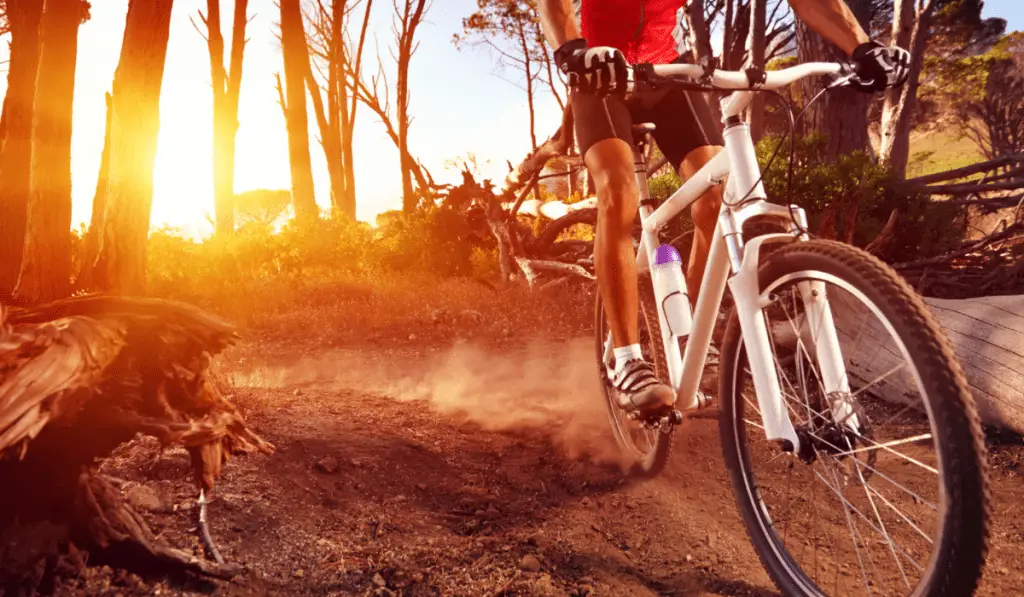Mountain biking provides nature lovers with a unique way to explore the great outdoors far from traffic-riddled roads. The activity also provides an opportunity for you to get your adrenaline pumping when you’re navigating different terrains so you can improve your bike handling skills.
If you’re a mountain biking enthusiast, you might have some questions about the best ways to achieve maximum efficiency from this form of exercise, and one of these questions might be ‘How many days a week should I mountain bike?’ We’ll be taking a closer look at what mountain biking offers you in terms of health and fitness while also providing information and tips so you can get the most out of your exercise.
How Many Days In A Row Can You Mountain Bike?
While mountain biking boasts a range of health benefits and provides the individual with a sense of adventure, it can be a strenuous activity that can take a toll on your body mentally and physically.
To reap the benefits of any form of exercise, you need to include rest days in your routine to prevent your muscles from being overworked.
During any taxing physical exertion in exercise, the muscle tissue tears, heals, and rebuilds to become stronger. These tears are microscopic in nature, and they can be a source of muscle soreness as the microtears lead to inflammation and pain.
Over time, the microtears in your muscles will eventually lead to an improved bloody supply in the area to support healing so that you can build muscle mass.
While the gradual breaking down and rebuilding of muscles can have benefits, there is a limit to the exertion as after frequent workouts, your glycogen (stores of glucose) levels are significantly reduced.
With these diminished levels, your body needs to recover, which can take up to four days, depending on your workout intensity. During this rest period, your muscles heal and grow so they can become stronger and improve your resistance to muscle soreness.
The number of days you can ride a mountain bike depends on your levels of fitness, activity, and genetic predisposition to muscle healing. On average, if you’re an amateur, you might benefit from two days rest in a week to prevent muscle fatigue.
On the other hand, professional athletes can go up to seven days a week without rest, but they’ll need to include a rest day in their routine in the next week.
Some professional athletes also prefer to switch out mountain biking for a less intense exercise on their day off, but the body has its limits, and you’ll need to take some time off to let your muscles rest and get quality sleep so you can be fit enough for your mountain biking efforts later in the week.
Mountain biking engages different muscle groups, including ones in the abdomen, arms, back, and legs. As you’ll be riding on different terrains while traveling downhill and uphill, you can work different muscles in your body which can help you get into shape.
Another key aspect of limiting muscle soreness is stretching beforehand, so the damage to your muscles is limited, which also results in shorter recovery periods.
A cooldown period is also important to get your heart rate and blood pressure back to normal levels, which regulates blood flow and also prevents muscle strain or tears by helping them go back to their original position.
The cooldown period begins the process of muscle recovery and prevents the delayed onset of muscle soreness which can impact the number of days you need to recover.
If mountain biking is the sport or fitness outlet of your choosing, you need to set goals such as losing weight, gaining muscle, or gaining endurance.
With a goal in mind, you’ll be better prepared to plan out your mountain biking adventures, and you can even supplement it with an appropriate diet to measure progress and reach your desired goal faster.
However, it is important to note that there is no hard and fast rule for setting rest days as there are several internal and external factors that affect your body, and you should be cautious about what your body is telling you and pick your rest days accordingly.
Read What Mountain Bike Size Am I
How To Ensure You’re Not Overdoing It?
Our body is a fine specimen that can endure severe pain, such as in childbirth, and it is built to heal itself within limitations through processes like blood clotting in an open wound and other healing mechanisms.
While the human body can be pushed hard physically and mentally, we need to pick up on warning signs and plan in advance to not keep the body in a constant flight, fight, and flight mode, which can have long-term negative consequences.
Here’s how you can keep your exercising efforts in check to ensure they provide maximum benefits for your body:
Lookout For Warning Signs
Our body is designed to be a well-oiled machine, and if there are glitches in the system, they present themselves in physical and emotional signs.
For example, if you’re overdoing your workouts, you might experience sleep apnea, muscle soreness, irritability, food cravings, and other symptoms that act as an indicator of what your body needs.
When these signs and symptoms present themselves, you need to listen to your body and take action to get it back on track so you can be in tiptop shape and make the most of your exercise routine.
Read How to Climb Faster on a Mountain Bike?
Set Realistic Fitness Goals
Only you know your body and its possibilities and challenges; while it is a good idea to push yourself during workouts, you should not discount factors such as age, fitness level, endurance levels, etc., when you’re mountain biking as some terrains might be too taxing for your body.
While some people can go for hours on a single track, this might not be the best or most effective workout routine for you. So remember to take a step back and evaluate your limits so you can settle on a realistic goal where you get the optimum workout without excessive wear and tear on your muscles.
Have A Training Plan In Place
Whether you’re into mountain biking for the adrenaline boost or you’re into professional racing, you need a proper plan in place to get the most from your workout.
A grading program for a mountain biker can include duration, a list of riding trails categorized according to levels of difficulty, a protein-rich diet plan, and rest days, to name a few, but you can customize it in any way you like.
Of course, this plan isn’t a hard and fast guide to mountain biking, as you’re about to experience some days where you might not be on track due to fatigue, injuries, or other issues, but it’s good to have a rough plan in place.
Plan To Avoid Burnout
While you might have a proper training plan in place, as a fitness or mountain biking enthusiast, you’ll need to include different exercises in your routine that can supplement your biking efforts.
By having a number of exercises from different categories, including cardio, weight training, flexibility training, etc., you can eliminate any monotony or burnout during your workouts.
The increased variety builds muscle strength, improves bone density and overall mobility and flexibility, which can help you work different muscles and become a better mountain biker.
Read How to Clean An Electric Mountain Bike?
Don’t Compromise On Your Recovery
Before you continue on your mountain biking adventures, you need to take a step back and rest so that you can reap the benefits of your exercise.
Your body needs to recover from intensive exercises, but this recovery period cannot be limited to one day a week as your body has to recuperate every day. Daily rehabilitation promotes performance which is why exercising and recovery go hand and hand.
At the same time, you should not deprive your body of essential nutrients and minerals that assist in growth and recovery, especially when it comes to carbohydrates, proteins, and fats.
Additionally, sleep is also an important factor for recovery as it boosts protein synthesis and aids in muscle recovery.
Identify Internal And External Stressors
When you mountain bike, you don’t operate in a vacuum there are several factors that affect your ability to make the most out of your mountain biking, and they can be primarily categorized according to internal and external stressors.
Internal stressors are related to the effects on your body of stressors such as financial issues, mental health issues, physical illnesses, etc. These stressors can affect your determination and effectiveness of the workout as they can affect your state of mind and focus.
External stressors are dependent on the surrounding environment, such as temperatures, altitude, weather conditions, etc. These stressors can physically impact your body; for example, high altitudes require periods of adaptation, so your body can get used to the lower oxygen concentration.
Similarly, it is more difficult to mountain bike during rainy or windy conditions as they can lead to injury or illness.
Once you identify your stressors, you can work on managing them and search for a mountain biking routine accordingly.
Read Best mountain biking backpacks in the market now
Take A Break When You Need It
You need to know when to push forward and when to take a step back. There’s no shame in taking care of your mental and physical well-being, and it should be prioritized over any routine that you have set for yourself.
When it comes to mountain biking, we’re sure there’s a reason why you love the activity, whether it’s for purely exercise reasons or you just enjoy the scenery and sense of adventure.
However, you cannot lose focus on your goals, and in the process, you also need to realize that you need to focus on listening to your body and its needs. So, take a break when you feel like you need it, so you can get back on the bike and continue to enjoy your ride.

Read Are Mountain Bike Tires Tubeless?
Final Thoughts
Mountain biking isn’t for everyone, but if you’re into adventurous sports and prefer to get your rush of adrenaline from navigating different landscapes, this might be the workout for you.
While there are several benefits of mountain biking, it can also be a stressful activity that can take a toll on your muscles and overall body. The key to getting the most out of mountain biking is through proper planning and listening to your body when it feels sore.
There might not be a single method to determine the right time to take a break from mountain biking, but if you’re thinking about mountain biking every day, you’ll need to reevaluate your strategy as a rest period is essential for muscle recovery and development.
Related mountain bike articles:
- How Much Does a Mountain Bike Weigh?
- How to Install A Rear Derailleur on A Mountain Bike?
- Best electric mountain bikes for women
- How to Ride an Electric Mountain Bike
- How to Put a Motor on a Mountain Bike

I am Michael, an avid rider and bike expert. I am here to provide, biking tips and expert advice on in-depth bike reviews covering features, capabilities, price range, and much more. Specially on electric bikes, mountain bikes, road bikes, etc. I will provide honest product reviews, along with expert advice on purchasing, training, and maintenance. Check out my complete profile.



